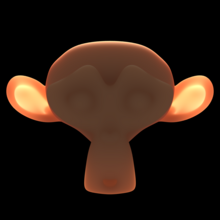Volume scatter
Volume scattering ( English subsurface scattering , abbreviation SSS ) describes the scattering of light in translucent bodies .
principle
Translucent bodies are partially translucent. In contrast to opaque bodies, they reflect incident light not only directly on their surface, but sometimes only after it has penetrated the matter.
In the case of some bodies, the reflection takes place on a layer below the solid surface, for example mirror glass, which has an almost completely reflective silver layer under a transparent glass layer. In other bodies, several partially translucent layers lie on top of one another, e.g. B. with organic materials such as skin and cellulose . Bodies like gas clouds are simply not dense enough to act as a solid surface; Whether and when the light hits a reflective particle is determined by chance. In still other substances, mainly emulsions such. B. Milk , different substances are mixed with different light transmittances; the light is reflected back and forth between accumulations of matter.
Translucent bodies apparently violate the law of reflection through these effects , because if you look at the outer surface, the angle of reflection and angle of incidence are by no means always the same - more than that: A light beam can enter the body at one point at an angle and at a completely different point below one exit completely different angle. This effect makes the behavior of light practically unpredictable. The probability distribution of the exit points and angles of the light rays corresponding to the entering light ray can be modeled with a BSSRDF .
Importance in computer graphics
The volume scatter is important in 3D computer graphics , in which one tries to simulate the appearance of materials such as skin, marble, milk or clouds as faithfully as possible.
One of the rendering methods that can be used to simulate volume scattering is photon mapping . A so-called volume photon map is used here; this method was introduced in 1998. Also Metropolis Light Transport , a rendering method for global illumination can be used to simulate volume scattering.
In 2001 an approximation method was developed which, in the case of negligible differences for many applications, significantly reduces the time required compared to these methods. This so-called dipole approximation was published by Henrik Wann Jensen and others in a SIGGRAPH publication and further developed in 2002. In 2005 the process was further developed to simulate thin objects and several differently scattering layers.
A newer, more efficient method for simulating volume scattering and other effects are multidimensional lightcuts .
Examples of applications of volume scattering are the films Matrix 2 , Matrix 3 , Shrek and the character of Gollum in the films of The Lord of the Rings trilogy.
Web links
- Sample pictures by Henrik Wann Jensen ( Memento from October 10, 2017 in the Internet Archive )
- SSS graphics demonstration for ATI Radeon graphics cards ( Memento from August 12, 2012 on the Internet Archive ) Video
- PixelBox Academy ( Memento from March 11, 2007 in the Internet Archive )
- www.lamrug.org - Tips, tricks and tutorials for the use of SSS ( Memento of July 2, 2012 in the Internet Archive ) (English)
- SSS for use on (human) skin - for Mental Ray ( Memento from January 31, 2012 in the Internet Archive ) (English; PDF; 1.45 MB)
- The use of physically almost correct SSS in Mental Ray ( Memento from June 17, 2012 in the Internet Archive ) (English; PDF; 2.95 MB)
- Theory and use of SSS in Mental Ray ( Memento from October 12, 2007 in the Internet Archive )
swell
- ↑ Henrik Wann Jensen, Per H. Christensen: Efficient simulation of light transport in scenes with participating media using photon maps. In: Proceedings of SIGGRAPH 1998
- ↑ Mark Pauly, Thomas Kollig, Alexander Keller: Metropolis Light Transport for Participating Media ( Memento from June 26, 2007 in the Internet Archive ) (PDF file, 1.8 MB) In Proceedings of the Eurographics Workshop on Rendering Techniques 2000
- ↑ Henrik Wann Jensen, Stephen R. Marschner, Marc Levoy, Pat Hanrahan: A Practical Model for Subsurface Light Transport. (PDF file, 2.3 MB) In Proceedings of SIGGRAPH 2001
- ↑ Henrik Wann Jensen, Juan Buhler: A Rapid Hierarchical Rendering Technique for Translucent Materials. ( Memento of October 30, 2011 in the Internet Archive ) (PDF file, 1.1 MB) In Proceedings of SIGGRAPH 2002
- ↑ Craig Donner, Henrik Wann Jensen: Light Diffusion in Multi-Layered Translucent Materials. ( Memento of September 8, 2017 in the Internet Archive ) (PDF file, 6.5 MB) In Proceedings of SIGGRAPH 2005
- ↑ Bruce Walter et al.: Multidimensional Lightcuts. (PDF file, 2 MB) In Proceedings of SIGGRAPH 2006

